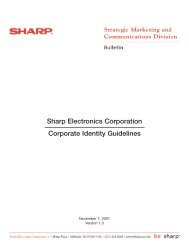IPG ingredient brand style guide HP Vivera
IPG ingredient brand style guide HP Vivera
IPG ingredient brand style guide HP Vivera
Create successful ePaper yourself
Turn your PDF publications into a flip-book with our unique Google optimized e-Paper software.
<strong>HP</strong> ViVera Style Guide > contentS > GloSSary of termS<br />
Glossary of terms<br />
Brand architecture - an organizing structure of the <strong>brand</strong><br />
portfolio that specifies <strong>brand</strong> roles and the nature of relationships<br />
between <strong>brand</strong>s.<br />
Branded differentiator - a <strong>brand</strong>ed feature, <strong>ingredient</strong>, service<br />
or program that creates a point of differentiation for a <strong>brand</strong>ed<br />
offering that is meaningful for customers and merits active<br />
management over an extended period of time.<br />
Branded element - an element in the overall <strong>brand</strong> architecture<br />
portfolio that is <strong>brand</strong>ed including sub<strong>brand</strong>s, <strong>ingredient</strong> <strong>brand</strong>s<br />
and <strong>brand</strong>ed differentiators.<br />
Copy - text that has been written in a final form for external<br />
communications to a specific audience in a specific communications<br />
vehicle (i.e., the words we use to communicate with our customers,<br />
partners, investors and each other). <strong>HP</strong> research shows that copy<br />
written in a relevant and reassuring manner is more likely to aid<br />
the sale.<br />
Customer segment - a group of customers with similar characteristics that<br />
are also significantly different from other groups in the same model.<br />
Endorser <strong>brand</strong>s - Give credibility and substance to the offering and<br />
are usually organizational or parent <strong>brand</strong>s.<br />
Ingredient <strong>brand</strong> - a type of <strong>brand</strong>ed differentiator that <strong>brand</strong>s the<br />
<strong>ingredient</strong> or technology to imply a benefit or a unique<br />
value proposition.<br />
Master <strong>brand</strong> - the primary indicator of the offering and the point<br />
of reference. Visually it will usually take top billing.<br />
Master <strong>brand</strong> characteristics - characteristics that <strong>HP</strong> has<br />
determined uniquely support the <strong>HP</strong> <strong>brand</strong> promise: inspired,<br />
Genuine and trusted.<br />
Master <strong>brand</strong> promise - a <strong>brand</strong> Promise is what we stand for (i.e.,<br />
the commitment we make to our customers, partners and each<br />
other). it defines the very essence of who we are, what we do and<br />
how we do it. the <strong>HP</strong> <strong>brand</strong> Promise has evolved over time based<br />
on our <strong>brand</strong> strategy. as of may 2006, the promise at the heart of<br />
the <strong>HP</strong> <strong>brand</strong> is: “we can help you do that.”<br />
Messaging - Phrases that provide guidance for what we want to<br />
tell the marketplace about a <strong>brand</strong>, initiative, technology, product,<br />
etc. messaging is the first step in translating our positioning into<br />
a conversation with customers, partners, investors and each other.<br />
messages are not applied literally, word for word, externally, but<br />
are instead used to inspire communication through development of<br />
copy, which is applied through specific communication vehicles.<br />
messages may be regionalized.<br />
Product <strong>brand</strong> - defines a specific product offering within the <strong>brand</strong><br />
portfolio. Product <strong>brand</strong>s fit with and support the master <strong>brand</strong> and<br />
receive limited investment.<br />
Sub<strong>brand</strong> - modifies the associations of a master <strong>brand</strong>, which<br />
remains the primary frame of reference. Sub<strong>brand</strong>s can add<br />
associations, a <strong>brand</strong> personality and even energy – and in doing<br />
so, stretch the master <strong>brand</strong> into new markets, segments, etc.<br />
Sub<strong>brand</strong> role - the strategic purpose for an element of the <strong>brand</strong><br />
architecture (e.g., master <strong>brand</strong>, sub<strong>brand</strong>, endorser <strong>brand</strong>, product<br />
<strong>brand</strong>, <strong>brand</strong>ed differentiator or <strong>ingredient</strong> <strong>brand</strong>); the reason it<br />
exists; what it is/what it does.<br />
Sub<strong>brand</strong> scope - the extent to which the <strong>brand</strong>ed element spans<br />
product categories and markets and the value spectrum, now and in<br />
the future.<br />
Sub<strong>brand</strong> persona - the traits that define the sub<strong>brand</strong>ed<br />
element’s voice, character and unique identity as part of the<br />
<strong>HP</strong> <strong>brand</strong> system.<br />
back forward SkiP to next cHaPter<br />
Sub<strong>brand</strong> positioning - Positioning articulates how a company<br />
wants their target customers to think and feel about a <strong>brand</strong>.<br />
it should create a unique image or identity in the minds of the<br />
customers. it is expressed relative to the position of competitors<br />
and can include both functional and emotional benefits. ultimately,<br />
positioning is about cultivating difference and relevance at every<br />
opportunity – from product development to customer touchpoints<br />
– to create loyal and committed customers.<br />
Sub<strong>brand</strong> product families - the specific product categories the<br />
sub<strong>brand</strong> covers, now and in the future.<br />
Target customer - the customers to whom the <strong>brand</strong>ed element is<br />
marketed and for whom the products are designed; the target must<br />
represent adequate size and profitability and will map to the go-tomarket<br />
worldwide segmentation.<br />
Value proposition - an internal statement summarizing the<br />
customer targets, competitor targets and the core strategy for how<br />
one intends to differentiate one’s product from the offerings of<br />
competitors. the value proposition should answer the question:<br />
“why would i buy this product?” for the customer.














